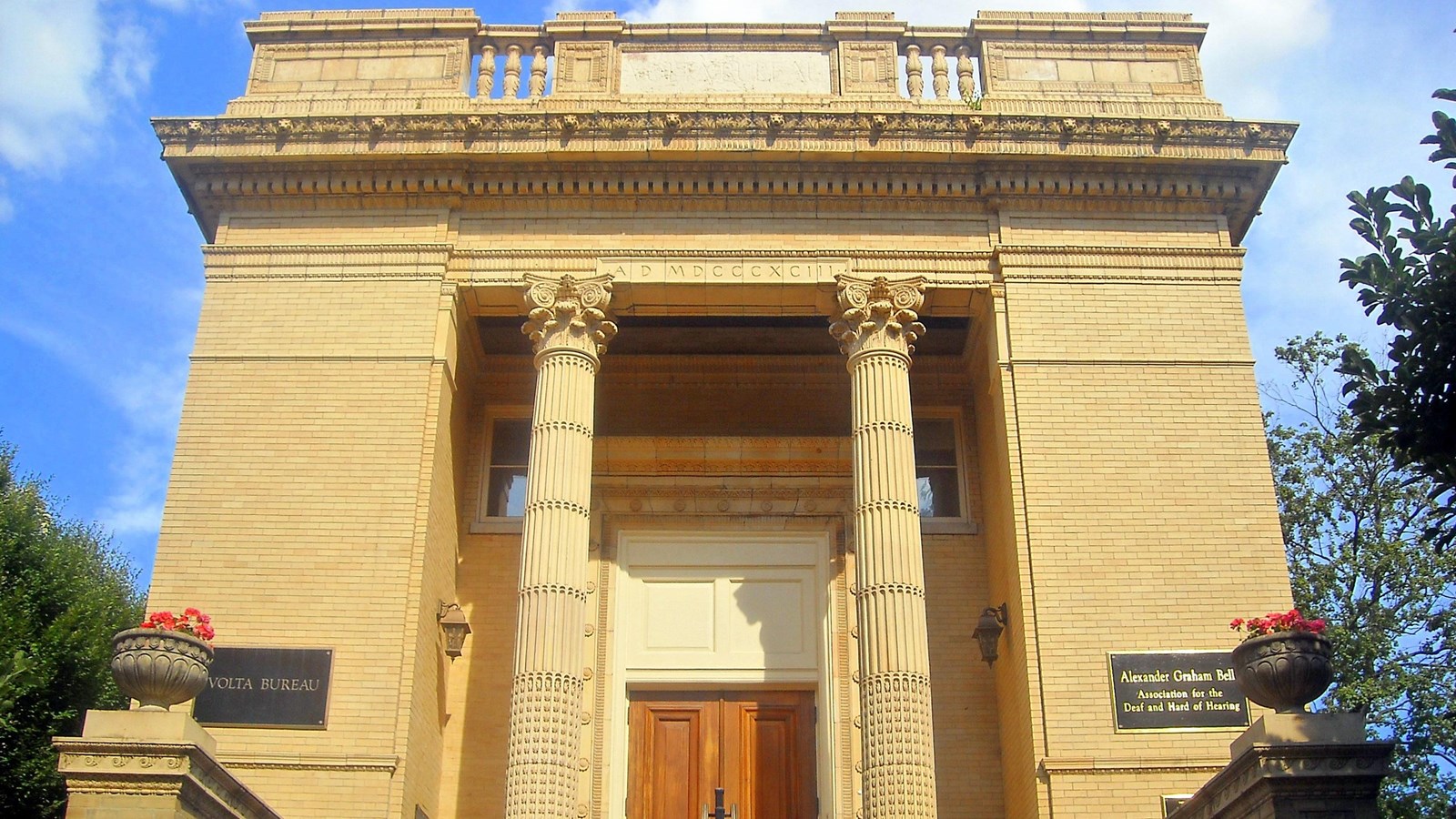Last updated: September 27, 2024
Place
Volta Bureau

AgnosticPreachersKid, CC BY-SA 3.0
In 1887, Alexander Graham Bell, inventor and deaf educator, founded the Volta Bureau to serve as a library for deaf people and those researching deafness. Originally housed in his father's carriage house across the street, by 1893, the Bureau's work had outgrown the space. Bell commissioned the impressive neoclassical yellow brick and sandstone building at 3417 Volta Place, NW, Washington, DC to be the new headquarters of the Bureau. Bell, who is best known for receiving the first telephone patent in 1876, was also an outstanding figure in early research in deaf education. The building serves as a reminder of Bell's dedicated work to advance the education of the deaf and sound technology in general.
Born in Edinburgh, Scotland, Bell came from a family of educators. His grandfather and father were both teachers of speech. In 1870, Bell moved with his family to Canada. One year later, he moved to Boston to teach at a special day school for deaf children. By 1872, he was teaching vocal physiology at Boston University. He also started a series of conventions for teachers who taught speech to the deaf.
In 1873, Bell and his associate, Thomas Watson, began experimenting with the telegraph. In 1876, Bell received the first telephone patent for his invention of an electric speaking telegraph. In 1878, Bell and his wife, Mabel Hubbard, moved from Boston to Washington, DC. The following year, the French government awarded Bell the Volta Prize of 50,000 francs (around $10,000) for his invention of the telephone. Bell used the money to found the Volta Laboratory in Georgetown with his cousin and a friend. The team researched sound recording and transmission. In 1887, they sold their record patents to the American Gramophone Company. Bell used his part of the profits to found the Volta Bureau—an organization established "for the increase and diffusion of knowledge relating to the Deaf."
The Bureau, which was first located at Bell's father's house that still stands across the street from the Volta Bureau building, worked in close cooperation with the American Association for the Promotion of the Teaching of Speech to the Deaf, organized in 1890. When the work of the Bureau outgrew Bell's father's house, Bell constructed a new building, which still houses the Volta Bureau library today. Famous deaf activist Helen Keller was present at the groundbreaking in Georgetown. By 1895, the three-story building had catalogued over 50,000 reference cards. The Bureau published the Volta Review to publicize its library.
Bell's approach to deaf education differed from other prominent deaf advocates. Unlike other educators of his day, including Edward Minor Gallaudet, founder of Gallaudet University, the first advanced learning center for the deaf in the world, Bell did not support the development of American Sign Language and did not believe in separate schools for deaf children. Through his research, he concluded that deaf students could excell without being segregated from hearing students. Instead of sign language, Bell advocated lip-reading. He did not want deaf people to be marginalized in society. Bell also visited numerous deaf schools throughout the country.
During the last 25 years of his life, Bell was chiefly interested in aviation. In 1883, he co-founded Science, a leading academic journal. From 1896 to 1904, Bell was president of the National Geographic Society. He also served as president of the American Association for the Promotion of the Teaching of Speech to the Deaf and donated over $300,000 to the organization. He died on August 2, 1922, and was buried on Cape Breton Island, Nova Scotia, where he had a large summer estate. The Alexander Graham Bell Association for the Deaf and Hard of Hearing still operates out of the Volta Bureau building reminding all who visit of Bell’s influential research.
Sources:
Van Cleve, John Vickrey, ed. The Deaf History Reader. Washington, DC: Gallaudet University Press, 2007.
Gannon, Jack R. Deaf Heritage: A Narrative History of Deaf America. Washington, DC: Gallaudet University Press, 2012.
Gray, Charlotte. Reluctant Genius: Alexander Graham Bell and the Passion for Invention. New York: Arcade Publishing, 2006.
National Historic Landmark Nomination for the Volta Bureau.
National Historic Landmarks (NHLs) are historic places that possess exceptional value in commemorating or illustrating the history of the United States. The National Park Service’s National Historic Landmarks Program oversees the designation of such sites. There are just over 2,500 National Historic Landmarks. All NHLs are also listed in the National Register of Historic Places.
